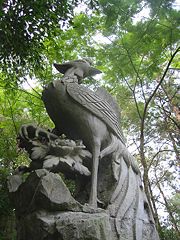Feng-huang
Feng-Huang(Chinese: 鳳凰; Pinyin: Fènghuáng; Japanese: 鳳凰 hō-ō; Korean: 봉황 bonghwang; Vietnamese: Phượng Hoàng) is the name of two Chinese mythological birds that were centeral figures in ancient Chinese cosmology. Sometimes called the Chinese Phoenix, the Feng-Huang is a symbol of summer and spiritual balance, and along with the dragon, unicorn and tortoise, is one of the most high revered creatures in Chinese tradition.
Description
While it is depicted as one being, Feng-Huang is actually a composite of one male and one female bird. The Feng is the male, and the Huang is the female, although both sexes are depicted the same. (Modern tradition combined the Feng-Huang into one bird) The Feng-Huang is said to be made up of the beak of a cock, the face of a swallow, the forehead of a fowl, the neck of a snake, the breast of a goose, the back of a tortoise, the hindquarters of a stag and the tail of a fish. Its body symbolizes the six celestial bodies. The head is the sky, the eyes are the sun, the back is the moon, the wings are the wind, the feet are the earth, and the tail is the planets. Its feathers contain the five fundamental colors: black, white, red, blue and yellow.
Unlike the Phoenix of the Western World, the Feng-Huang is immortal without needing to go through a cycle of death and re-birth. The bird is attracted to music and nests high in the K'unlun Mountain range.[1]
Origin
Fenghuang, the Chinese phoenix, has no connection with the phoenix of the Western world[citation needed]. The images of the phoenix have appeared in China for over 7,000 years, often in jade and originally on good-luck totems. It is a totem of eastern tribes in ancient China. Current theories suggest that it may be a representation of a large pre-historic bird, similar to an ostrich, which were common in pre-historic China.
During the Han Dynasty (2,200 years ago) the phoenix was used as a symbol depicting the direction south, shown as a male (feng, 鳳) and female (huang, 凰) phoenix facing each other. It was also used to symbolize the Empress in a pairing with a dragon where the dragon represents the Emperor. It might come from the merging of eastern and western tribes of ancient China. The phoenix represented power sent from the heavens to the Empress. If a phoenix was used to decorate a house it symbolized that loyalty and honesty were in the people that lived there. Or alternatively, phoenix only stays when the ruling is without dark and corruption (政治清明).
Meaning
The Fenghuang has very positive connotations. It is a symbol of high virtue and grace. The Fenghuang also symbolizes the union of yin and yang. It appears in peaceful and prosperous times but hides when trouble is near.
In ancient China, they can often be found in the decorations for weddings or royalty, along with dragons. This is because the Chinese considered the dragon and phoenix symbolic of blissful relations between husband and wife, another common yin and yang metaphor.
Modern usage
- "Fèng talon" (鳳爪) is a Cantonese dish of chicken feet cooked in a black bean sauce.
- "Fènghuáng" is a common element in the names of Chinese girls (likewise, "dragon" for boys' names).
- "Dragon and Fèng infants" (龍鳳胎) is an expression meaning a set of boy and girl fraternal twins.
- Fenghuang is also a county in western Hunan province of China, formerly a sub-prefecture. Its name is written with the same Chinese characters as the mythological bird.
- In Korea, it has been used for the royal emblem or the presidential emblem.
Footnotes
- ↑ ["Feng Huang, Emperor of Birds"] Retrieved July 10, 2007
External links
Credits
New World Encyclopedia writers and editors rewrote and completed the Wikipedia article in accordance with New World Encyclopedia standards. This article abides by terms of the Creative Commons CC-by-sa 3.0 License (CC-by-sa), which may be used and disseminated with proper attribution. Credit is due under the terms of this license that can reference both the New World Encyclopedia contributors and the selfless volunteer contributors of the Wikimedia Foundation. To cite this article click here for a list of acceptable citing formats.The history of earlier contributions by wikipedians is accessible to researchers here:
The history of this article since it was imported to New World Encyclopedia:
Note: Some restrictions may apply to use of individual images which are separately licensed.

